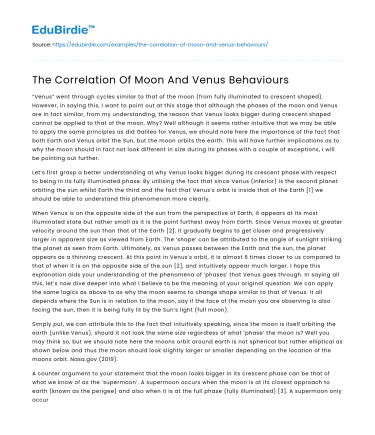“Venus” went through cycles similar to that of the moon (from fully illuminated to crescent shaped). However, in saying this, I want to point out at this stage that although the phases of the moon and Venus are in fact similar, from my understanding, the reason that Venus looks bigger during crescent shaped cannot be applied to that of the moon. Why? Well although it seems rather intuitive that we may be able to apply the same principles as did Galileo for Venus, we should note here the importance of the fact that both Earth and Venus orbit the Sun, but the moon orbits the earth. This will have further implications as to why the moon should in fact not look different in size during its phases with a couple of exceptions, I will be pointing out further.
Let’s first grasp a better understanding at why Venus looks bigger during its crescent phase with respect to being in its fully illuminated phase. By utilising the fact that since Venus (inferior) is the second planet orbiting the sun whilst Earth the third and the fact that Venus’s orbit is inside that of the Earth [1] we should be able to understand this phenomenon more clearly.
Save your time!
We can take care of your essay
- Proper editing and formatting
- Free revision, title page, and bibliography
- Flexible prices and money-back guarantee
When Venus is on the opposite side of the sun from the perspective of Earth, it appears at its most illuminated state but rather small as it is the point furthest away from Earth. Since Venus moves at greater velocity around the sun than that of the Earth [2], it gradually begins to get closer and progressively larger in apparent size as viewed from Earth. The ‘shape’ can be attributed to the angle of sunlight striking the planet as seen from Earth. Ultimately, as Venus passes between the Earth and the sun, the planet appears as a thinning crescent. At this point in Venus’s orbit, it is almost 6 times closer to us compared to that of when it is on the opposite side of the sun [2], and intuitively appear much larger. I hope this explanation aids your understanding of the phenomena of ‘phases’ that Venus goes through. In saying all this, let’s now dive deeper into what I believe to be the meaning of your original question. We can apply the same logics as above to as why the moon seems to change shape similar to that of Venus. It all depends where the Sun is in relation to the moon, say if the face of the moon you are observing is also facing the sun, then it is being fully lit by the Sun’s light (full moon).
Simply put, we can attribute this to the fact that intuitively speaking, since the moon is itself orbiting the earth (unlike Venus), should it not look the same size regardless of what ‘phase’ the moon is? Well you may think so, but we should note here the moons orbit around earth is not spherical but rather elliptical as shown below and thus the moon should look slightly larger or smaller depending on the location of the moons orbit. Nasa.gov (2019).
A counter argument to your statement that the moon looks bigger in its crescent phase can be that of what we know of as the ‘supermoon’. A supermoon occurs when the moon is at its closest approach to earth (known as the perigee) and also when it is at the full phase (fully illuminated) [3]. A supermoon only occur a few times a year because the “moons orbit changes orientation while the Earth orbits the sun (Howell, 2019).
Conclusively, the apparent ‘size’ of the moon all depends on the relative location in its orbit around earth and the ‘phase’ depends on the relative location to that of the sun (how much light is being illuminated onto it). I hope this clarifies your misconception that the moon behaves similar to that of Venus in terms of its apparent size in its different phase’s.
References
- Physics.ucla.edu. (2019). Venus.htm. [online] Available at: http://www.physics.ucla.edu/~huffman/venus.htm [Accessed 25 Sep. 2019].
- Rao, J. (2019). Bright Planet Venus Has Phases Like the Moon. [online] Space.com. Available at: https://www.space.com/23495-venus-planet-phases-explained.html [Accessed 25 Sep. 2019].
- Howell, E. (2019). What Is a Supermoon?. [online] Space.com. Available at: https://www.space.com/38940-supermoon-facts.html [Accessed 26 Sep. 2019].






 Stuck on your essay?
Stuck on your essay?

